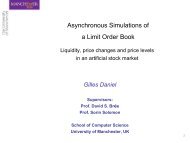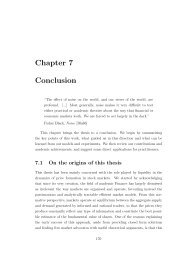market architecture of selected stock exchanges in ... - Gilles Daniel
market architecture of selected stock exchanges in ... - Gilles Daniel
market architecture of selected stock exchanges in ... - Gilles Daniel
You also want an ePaper? Increase the reach of your titles
YUMPU automatically turns print PDFs into web optimized ePapers that Google loves.
62 Prelim<strong>in</strong>ary Considerations2.1 The Stock Exchange <strong>in</strong> GeneralEvery <strong>stock</strong> exchange is a system where shares and other securities, issued bycompanies and listed by the exchange are traded. Though, probably the most obviousway to classify f<strong>in</strong>ancial <strong>market</strong>s corresponds to the type <strong>of</strong> securities traded <strong>in</strong> those<strong>exchanges</strong>. Traditional <strong>exchanges</strong> are subdivided <strong>in</strong>to currency, <strong>stock</strong>, andcommodity <strong>exchanges</strong> depend<strong>in</strong>g on the assets traded on them. The modern form <strong>of</strong>commodity exchange is the futures exchange.A <strong>stock</strong> exchange has two ma<strong>in</strong> functions: rais<strong>in</strong>g capital and trad<strong>in</strong>g. Rais<strong>in</strong>g capitaltakes place <strong>in</strong> the primary <strong>market</strong>. On the primary <strong>market</strong> shares <strong>of</strong> newly listedcompanies are issued by means <strong>of</strong> <strong>in</strong>itial public <strong>of</strong>fer<strong>in</strong>gs. Furthermore, there arerights issues by exist<strong>in</strong>g companies quoted on the exchange. These issues arepurchased directly from the issuer and s<strong>in</strong>ce they are new they also affect the size <strong>of</strong>the equity pool. The secondary <strong>market</strong> is where these securities are actually traded <strong>in</strong>a regulated environment. The <strong>market</strong> participants determ<strong>in</strong>e the prices <strong>of</strong> thesecurities through supply and demand whereas <strong>in</strong> the primary <strong>market</strong> the <strong>in</strong>itial priceis set (JSE 2004). The third <strong>market</strong> comprises the over-the-counter trad<strong>in</strong>g <strong>of</strong> listedsecurities among non-exchange members, e.g. <strong>in</strong>stitutional <strong>in</strong>vestors andbroker/dealers. The fourth <strong>market</strong> <strong>in</strong>volves direct trad<strong>in</strong>g <strong>of</strong> securities between<strong>in</strong>stitutional <strong>in</strong>vestors through a computer network rather through an exchange <strong>in</strong>order to avoid transaction costs (Reilly 1986).







